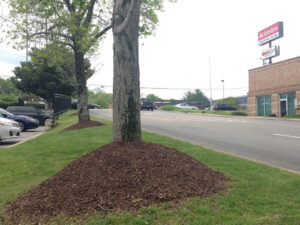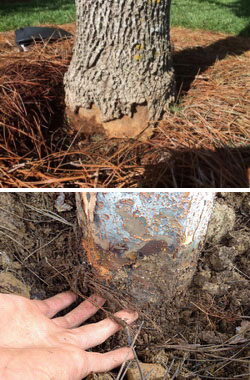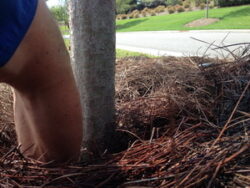The woes of volcano mulching
As an arborist, I drive around the city estimating on a daily basis. In doing so, I am routinely shocked by the explosion of “volcano mulching” of trees (Figure 1)—in yards, in medians, in parking lot islands, and well, pretty much anywhere there is a new tree planting going in the ground (or so it seems). It is spreading like a plague across our city.

Figure 1. Volcano mulching, a guaranteed way to kill your trees.

Figure 2. Negative effects of volcano mulching.
Why is volcano mulching so destructive?
Volcano mulching is an extremely destructive practice, and is a guaranteed way to kill your trees prematurely—from new plantings to venerable old trees. When trees are volcano mulched, much of the mulch remains in direct contact with the tree’s bark. This constant moisture against the bark will eventually cause the bark to rot and separate from the tree (Figure 2; top), disrupting the translocation (i.e., movement) of water and nutrients throughout the tree. Also, by pulling back the mulch, I am often able to show how the fine feeder roots, instead of growing down into the native soils, instead, grow upward (into the (softer and often more nutritious) mulch mound; Figure 2; bottom). People are always astonished to see tree roots growing upwards!
So, are you saying don’t mulch my trees?
Absolutely not. Properly mulching trees is highly-desirable and one of the most beneficial ways to protect them, slowly feed them, add aesthetic beauty, and ensure their long-term survival. Properly applied, rich, organic mulches are extremely valuable to a tree’s overall health; they are also multi-functional. When properly applied, mulch conserves soil moisture, helps to cool surface temperatures around the tree’s root zone, and improves soil structure. But just as important as these biological benefits, properly applied mulch, simply put, keeps people, weed eaters, lawnmowers, and vehicles away from (and off of) your tree’s root zone!

Figure 3. Improperly-applied mulch. I had to dig down 12” just to touch the native soil.
Why is improper mulching so prevalent?
Remember that landscapers are not arborists, and arborists are not landscapers. While it may seem cheaper to just have a landscaper come in each year and dump a new wheelbarrow full of mulch onto your existing mulch mounds, if left to their own devices, they will continually lay down mulch until it extends well up the trunk of the tree (I have seen volcano mulch mounds that exceed 20” in height up the tree trunk!; Figure 3). Another reason volcano mulching seems to be so prevalent, is that people “like the aesthetics of volcano mulching”. We humans sure do like symmetry, but nature is rarely symmetrical, so why not work with nature and try to provide a mulching system that more closely resembles the forest floor.

Figure 4. A landscape with properly applied mulch.
What’s the solution?
If your trees have been volcano mulched for years, there may be little that can be done (as many of the fine feeder roots have since developed upwards into the mulch mound making it impossible to rake back the mulch pile without exposing/killing these feeder roots). If you are starting with new plant stock, take caution when looking for installation companies. Ask questions, consult with an arborist, or do your own research about the negative consequences of volcano mulching.
Mulch should be no more than 3”- 4” thick and (ideally) should extend all the way out to the drip line of the tree (i.e., to the length of the furthest horizontal branches) for any of the benefits listed above to be provided to the tree. Since there are few feeder roots close the trunk, any mulch applied here (such as in volcano mulching) is of no use at all to the tree. No mulch should remain in direct contact with the tree’s bark—ever. You should always be able to see the “trunk flare” of a tree following mulching. Mulch should be of high-quality and spread evenly over the tree’s entire root zone to allow those fine, fibrous, feeder roots to better absorb (and seek out) water and nutrients (Figure 4).
About the Author:
Lee Rumble is an ISA Certified Arborist with Community Tree Preservation in Nashville, Tennessee.


Thank you! What do you suggest as a way to approach communities to suggest they stop doing this? One of our problems is landscape contractors that pile on the mulch and poorly plant trees. I think they are just selling extra mulch and are lazy, but I do not know. Makes me furious.
Kathleen Bradley – Sherwick Tree Steward (Western Reserve Land Conservancy) in NE Ohio.
More, trees also respirate from their root crowns. Burying the root crown reduces their capacity for respiration.
My young but maturing Norweigan maples have shallow roots showing just above the ground. Recently, I may have volcano mulched, but not over 3-4”. Should I simply remove mulch from the trunk? …leaving more of a doughnut mulching than a volcano?
Thank you for raising this. It blows my mind to see this practice ‘mushrooming’ across the city.